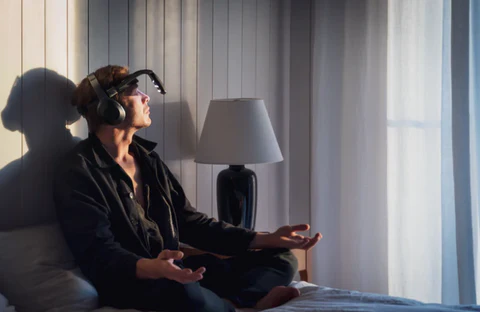In the hustle and bustle of modern life, achieving restorative and rejuvenating sleep can often feel like an elusive goal. Yet, nestled within the depths of our nightly slumber lies a key stage crucial for cognitive function, emotional regulation, and overall well-being: Rapid Eye Movement (REM) sleep. Understanding the intricacies of the sleep cycle, including its various stages and factors that impact them, is essential for unlocking the secrets to improving REM sleep.
In this comprehensive guide, we embark on a journey through the realm of sleep, exploring the stages of the sleep cycle, the significance of REM sleep, and practical strategies to enhance its quality. Whether you’re seeking to increase REM sleep duration, improve sleep continuity, or simply achieve a deeper and more restful night’s rest, this blog is your roadmap to achieving better REM sleep and reaping its myriad benefits.
Join us as we dive into the science behind the sleep cycle, uncover the factors that influence REM sleep, and discover actionable tips to optimize your sleep environment and habits. Let’s embark on this transformative journey toward unlocking the full potential of your nightly slumber and awakening refreshed, revitalized, and ready to seize the day.
Understanding the Sleep Cycle:
A sleep cycle is a recurring pattern of distinct stages that our brains and bodies go through during a typical night’s sleep. These cycles typically last around 90 to 110 minutes and repeat throughout the night, with most individuals experiencing several cycles. Each sleep cycle consists of four stages: three stages of non-rapid eye movement (NREM) sleep and one stage of rapid eye movement (REM) sleep.
Non-Rapid Eye Movement (NREM) Sleep:
1. Stages: NREM sleep consists of three stages: Stage 1, Stage 2, and Stage 3 (also known as slow-wave sleep or deep sleep).
2. Brain Activity: During NREM sleep, brain activity gradually decreases from wakefulness to deeper levels of sleep. Brain waves become slower and more synchronized.
3. Physical Characteristics: Muscle tone decreases progressively throughout NREM sleep, reaching its lowest point during Stage 3. Breathing and heart rate slow down, and body temperature decreases.
4. Functions: NREM sleep is essential for physical restoration and growth. It promotes muscle repair, tissue growth, and immune function. Stage 3 NREM sleep, in particular, is crucial for overall physical recovery and rejuvenation.
Rapid Eye Movement (REM) Sleep:
1. Stage: REM sleep is a distinct stage of sleep characterized by rapid eye movements, increased brain activity, and vivid dreaming. It typically occurs after a period of NREM sleep.
2. Brain Activity: During REM sleep, brain activity increases to levels comparable to wakefulness. However, the body remains largely paralyzed, except for the eyes and certain muscles involved in breathing.
3. Physical Characteristics: Despite increased brain activity, the body enters a state of muscle atonia or paralysis during REM sleep. Breathing and heart rate become irregular, and blood pressure may rise. REM sleep is also associated with increased blood flow to the brain.
4. Functions: REM sleep plays a crucial role in cognitive processes such as memory consolidation, emotional regulation, and creativity. It is believed to facilitate learning and problem-solving by integrating new information with existing knowledge. REM sleep is also associated with emotional processing and regulation, helping to maintain mental health and well-being.
The 4 Stages of Sleep:
1. NREM 1: This is the transition stage between wakefulness and sleep. During Stage 1, you may feel drowsy and relaxed, but you can still be easily awakened. Brain activity begins to slow down, and you may experience drifting thoughts or sudden muscle contractions known as hypnic jerks.
2. NREM 2: In Stage 2, your body further relaxes, and your brain waves continue to slow down with occasional bursts of rapid brain activity known as sleep spindles. During this stage, your body temperature drops, and your heart rate begins to slow down. Stage 2 sleep is considered a deeper stage of sleep than Stage 1, and it becomes progressively harder to wake you up.
3. NREM 3: This is the deepest stage of NREM sleep, also known as slow-wave sleep (SWS) or delta sleep. During Stage 3, your brain produces slow delta waves, and your muscles relax completely. It’s the most restorative stage of sleep, crucial for physical recovery, growth, and immune function. Waking up from Stage 3 sleep can leave you feeling groggy or disoriented.
4. REM Sleep: Rapid Eye Movement (REM) sleep is characterized by increased brain activity, rapid eye movements, and vivid dreaming. Despite the brain being highly active during REM sleep, the body remains mostly paralyzed, except for the eyes and certain muscles involved in breathing. REM sleep is essential for cognitive function, emotional regulation, and memory consolidation.
After the REM stage, the sleep cycle typically repeats itself, with each subsequent cycle containing progressively longer periods of REM sleep and shorter periods of deep NREM sleep. As the night progresses, the duration of REM sleep increases while the duration of deep NREM sleep decreases.
The sleep cycle is orchestrated by the complex interaction of various neurotransmitters, hormones, and brain regions, all working together to regulate the timing and duration of each stage of sleep. Disruptions to the sleep cycle, such as sleep disorders or environmental factors, can impact the quality and restorative benefits of sleep, leading to daytime fatigue, cognitive impairment, and other health issues.
Factors Interfering with Sleep Cycle and Stages:
The sleep cycle is a complex and dynamic process influenced by various internal and external factors. Understanding these influences is essential for optimizing sleep quality and overall well-being. Here are some key factors that can impact the sleep cycle:
1. Circadian Rhythm: Our bodies operate on a 24-hour internal clock known as the circadian rhythm, which regulates sleep-wake cycles. Disruptions to this rhythm, such as irregular sleep schedules or exposure to artificial light at night, can disrupt the natural sleep cycle.
2. Age: Sleep patterns change throughout the lifespan, with infants and young children requiring more sleep and experiencing more frequent REM sleep cycles. As we age, the amount of deep sleep and REM sleep tends to decrease, leading to more fragmented sleep patterns.
3. Stress and Anxiety: High levels of stress and anxiety can disrupt the sleep cycle by increasing arousal and interfering with the ability to fall asleep or stay asleep. Chronic stress can lead to sleep disorders such as insomnia or sleep disturbances during REM sleep.
4. Lifestyle Factors: Certain lifestyle factors, such as shift work, irregular sleep schedules, or excessive caffeine and alcohol consumption, can disrupt the sleep cycle and impair REM sleep. Additionally, sedentary behavior and lack of physical activity can negatively impact sleep quality.
5. Environmental Factors: The sleep environment plays a crucial role in promoting restful sleep. Factors such as noise, light, temperature, and comfort level can influence the sleep cycle and disrupt REM sleep if not optimized for sleep.
10 Ways to Improve REM Sleep at Night:
1. Establish a Consistent Sleep Schedule: Go to bed and wake up at the same time every day, even on weekends. Consistency helps regulate your body’s internal clock, promoting deeper REM sleep.
2. Create a Relaxing Bedtime Routine: Develop a calming pre-sleep ritual to signal to your body that it’s time to wind down. Activities such as reading a book, taking a warm bath, or practicing relaxation techniques like deep breathing can help prepare your mind and body for sleep.
3. Optimize Your Sleep Environment: Make sure your bedroom is conducive to sleep by minimizing noise, light, and electronic distractions. Invest in a comfortable mattress and pillows, and adjust the room temperature to promote a comfortable sleep environment.
4. Limit Stimulants Before Bed: Avoid consuming caffeine and nicotine in the hours leading up to bedtime, as they can interfere with your ability to fall asleep and disrupt REM sleep. Similarly, limit alcohol consumption, as it can fragment sleep and suppress REM sleep.
5. Manage Stress and Anxiety: Practice stress-reducing techniques such as mindfulness meditation, progressive muscle relaxation, or yoga to help calm the mind and reduce anxiety levels before bedtime. High levels of stress can inhibit REM sleep and lead to fragmented sleep patterns.
6. Exercise Regularly: Engage in regular physical activity during the day, but avoid vigorous exercise close to bedtime. Regular exercise can promote deeper, more restorative sleep, including REM sleep, by reducing stress and promoting relaxation.
7. Consider Dietary Factors: Be mindful of your diet, especially in the evening. Avoid heavy meals, spicy foods, and large amounts of fluid close to bedtime, as they can disrupt sleep and increase the likelihood of waking up during the night. Instead, opt for light, easily digestible snacks if you’re hungry before bed.
8. Limit Screen Time Before Bed: Reduce exposure to blue light from electronic devices such as smartphones, tablets, and computers before bedtime. Blue light suppresses melatonin production, disrupting the natural sleep-wake cycle and impairing REM sleep.
9. Practice Mindfulness and Relaxation: Incorporate mindfulness practices or relaxation techniques into your bedtime routine, such as deep breathing exercises, progressive muscle relaxation, or guided imagery. These techniques can help calm the mind and prepare the body for sleep, enhancing the transition into REM sleep.
10. Seek Professional Help if Needed: If you continue to experience difficulties with REM sleep despite implementing these strategies, consider consulting a healthcare professional or sleep specialist. They can help identify any underlying sleep disorders or medical conditions that may be impacting your sleep quality and provide personalized recommendations for improvement.
Introducing the AYO Wearable:
The AYO wearable, a cutting-edge device designed to harness the power of light therapy to support sleep and overall health, takes a unique approach to sleep enhancement by leveraging the principles of circadian biology and light exposure. At its core, the device resembles a sleek pair of glasses, equipped with LED lights that emit specific wavelengths of blue light. These lights are strategically designed to mimic the natural light spectrum of the sun, particularly during the morning hours when our bodies are primed to receive signals for wakefulness and alertness.
So, how does the AYO wearable support sleep? The key lies in its ability to influence our circadian rhythm, often referred to as our internal body clock. Our circadian rhythm regulates various physiological processes, including the sleep-wake cycle, hormone production, and metabolic functions. Exposure to natural light, especially in the morning, helps synchronize our circadian rhythm and promotes wakefulness and alertness during the day, while exposure to dim light or darkness in the evening signals to our bodies that it’s time to wind down and prepare for sleep.
The AYO wearable capitalizes on this natural mechanism by providing a convenient and portable way to expose ourselves to the right type of light at the right time. By wearing the device for short sessions during the morning hours, you can effectively simulate the sunrise and signal to your body that it’s time to wake up and start the day. This can help regulate sleep-wake cycles, improve energy levels, and enhance overall alertness and cognitive function throughout the day.
Embark on a journey to more REM sleep and improved well-being with the AYO wearable. Get yours here!
Introducing Vizr:
Vizr is an innovative brain wellness and relaxation device that uses sound and light therapy to enhance sleep quality by aligning with the body’s natural circadian cycle. Its Better Sleep sessions are strategically crafted to optimize sleep patterns by targeting different phases of the circadian rhythm. In the morning, Vizr optimizes the circadian response to promote alertness and vitality, setting the stage for a productive day ahead. During the afternoon, it helps alleviate stress and tension that may disrupt sleep rhythms, fostering a sense of relaxation and balance. Come evening, Vizr facilitates sleep induction, preparing both mind and body for a deeply restorative night’s sleep. By seamlessly integrating these tailored sessions into your daily routine, Vizr empowers you to experience a more revitalizing and rejuvenating rest, enhancing overall sleep health and well-being.
Get your Vizr here!




